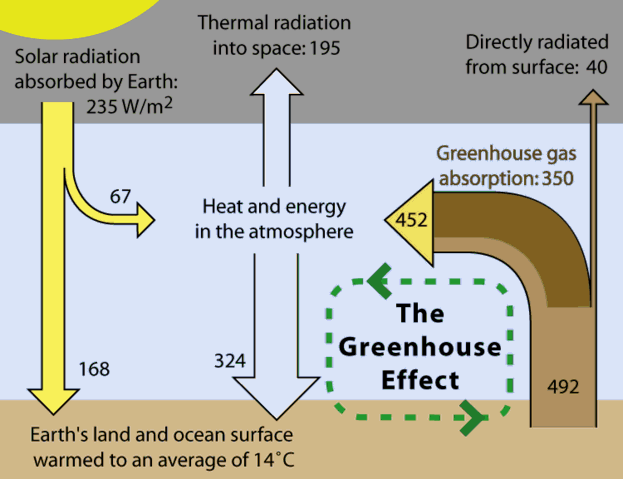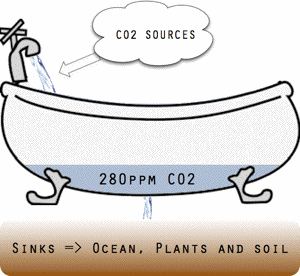 Climate
Change
Climate
ChangeClimate
 Gale
Christianson, Greenhouse, 1999.
Gale
Christianson, Greenhouse, 1999.
Contents | Quote | Preface | Analysis in parts | Part One | Part Two | Part Three | Graphic | |What's wrong | Signal | Policies | Needs
Greenhouse: The 200-year Story of Global Warming
Gale E. Christianson
(NYC, NY: Walker & Company, 1999)
Contents
Chapters,
Preface
Part One The Time Travellers
H.G. Wells: “The past is but the beginning of a beginning and all that is and has been is but the twilight of the dawn”
1, The Guillotine and the Bell Jar Fourier
2, The Cryptic Moth “believed that species were immutable....” CD
3, “Endless and as Nothing” “Time has no divisions to mark its passage”
Thomas Mann, Magic Mountain
Part Two The World Eaters
Herman Melville, “All my means are sane; my motive and my object mad.”
4, Quest for the Black Diamond poem “The Bells of Heaven” blind pit ponies
5, Cleopatra’s Needles Above the smoke and stir of this dim spot... Milton
6, Vulcan’s Anvil Can this fantastic Century move
7, The Phantom of the Open Hearth “fire burn and cauldron bubble.”
8, “The Dynamo and the Virgin” “the sudden eruption of forces totally new.”
Part Three “The Dwellers in the Crystal Palace”
Walter Lippmann: “...we are involved in the world’s problems.”
9, Native Son “But in science the credit goes to the man who convinces”
10, “Never A Man” One generation passeth away ... The sun also riseth”
11, Threshold “My candle burns at both ends; It will not last the night”
12, A Tap on the Shoulders George Callendar’s Dayton temp. records
13, Pendulum “Our interglacial summer passes quickly on.”
14, A Death in the Amazon- Hurt not the earth, neither the sea, nor the trees.
15, The Climatic Flywheel s clouds from both sides now ... Cloud illusions
16, Cassandra’s Listeners In nature’s infinite book of secrecy....
17, Signs & Portents “may this not be an omen”
18, Scenarios They set an ambush for their own lives Proverbs
19, Kyoto it is we who deceive ourselves JJ Rousseau
Coda
![]()
Preface
Deep time is introduced ice and snow are normal on Earth
“citizens of the ice ages”
Summary of the Global Warming Idea as a biography of a scientific discovery
x Pleistocene background & Global Warming
xi 200 year old discovery of GW & carbon dioxide
xii overview of the leading people in three parts
xiii every citizen needs to be familiar with the GW problem / debate.
Fourier 1820's earliest speculation on heat trapping gas in the atmosphere
(11-12)
"This is the sort of evidence that has lead at least some scientists to conclude that the signature of the increasing green house effect is already here -- not just something calculated for the 21st century, but here now."
Carl Sagan, January, 1990.
(211)
- Edith's Checkerspot butterfly's range extended north;
- coral reefs bleaching worldwide.
(212-213)
signal
carbon 13 isotopes in marine sediments are consistent with a major
gas release
acts as a tracer of warmer ocean temperatures and a release of methane
(from a cold trap)
(221)
impact
17-43% loss of wetlands (EPA) due to a 2 foot sea level rise.
(245)
Political agreements to reduce carbon dioxide pollution
Kyoto Protocol (1997): Nations C02 emissions
USA 7% reduction
Japan 6% reduction
EUC 8% reduction
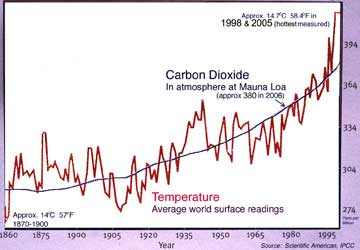
PART by Part Analysis:
PART One background
The science
Time has to be discussed due to the idea of fossils, carboniferous age and fossil fuels such as coal, gas and oil.
PART Two frames the conditions of the debate
The technological changes
The industrial Revolution as a driver of and producer of evidence for a faith in progress is introduced as having had a cost for some despite the proponents of industrial benefits.
Chimneys to remove smoke from the immediate area as a technological (temporary) fix.
Hotter and hotter furnaces in which to burn fuels more efficiently and produce better grade iron and steel.
Steam engines to drain coal mines, textile automation put weavers out of work, coal was coked to more efficiently make iron, that was used in transportation.
PART Three discovery, synthesis and argument
The science and policy debates
greenhouse gas: carbon dioxide, nitrous oxides, methane, CFCs
• good
longer growing seasons, fertilize plants, reintroduce crops
• not good
glaciers and tundra melt, release of methane (potent GHG), sea level rises and floods low lying coastal areas (London, Venice).
What are the appropriate actions to take?
Adaptive versus preventive.
Adaptive dykes building codes “clean coal” plant trees
Preventive: drive less efficiency conserve energy forest protection
Kyoto -- the international character of air pollution, trans-boundary problem
PART One
background
The science
pages: 3-36.Time has to be discussed due to the idea of fossils, carboniferous age and fossil fuels such as coal, gas and oil.
Fourier and the vapor gas hypothesis as heat absorptive, hence a heat trap.
Genetics and the idea humans can influence nature with unintended consequences of industrial melanism.
Darwin, Button, Lyell, uniformitarianism and geological time: gradualism.
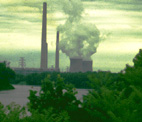 A coal-fired (fueled) electrical generating plant on the Ohio River.
A coal-fired (fueled) electrical generating plant on the Ohio River.
frames the conditions of the debate
The technological changes
pages: 37-102.The Industrial Revolution as a driver of and producer of evidence for a faith in progress is introduced as having had a cost for some despite the proponents of industrial benefits.
Chimneys to remove smoke from the immediate area as a technological (temporary) fix.
Hotter and hotter furnaces in which to burn fuels more efficiently and produce better grade iron and steel.
Steam engines to drain coal mines, textile automation put weavers out of work, coal was coked to more efficiently make iron, that was used in transportation.
Discovery of oil by drilling and the refinery business of J. D. Rockefeller & Standard oil: vertical and horizontal integration of business based on fossil fuels.
Internal combustion engine and mass production of automobiles, Ford.
Alfred Russell Wallace and George Perkins Marsh reveal that humans as agents of geological change.
Deforestation
desertification
drainage affects soil moisture and climateHenry Adams and the dynamo in the world’s fair -- unseen forces altering society.
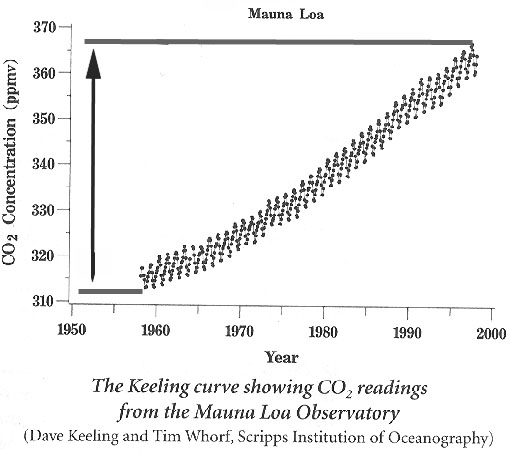
discovery, synthesis and argument
the science and policy debates
pages: 103-277.greenhouse gases: carbon dioxide, nitrous oxides, methane, CFCs,
• good
longer growing seasons, fertilize plants, reintroduce crops• not good
glaciers and tundra melt, release of methane (potent GHG), sea level rises and floods low lying coastal areas (London, Venice).
Cycles of the climate and reasons for these: axial wobble, elliptical distension, solar cycles of flares and sunspot activity.
Anasazi in the desert SW, 1200s extreme and lasting dryness
Viking advance and retreat from Greenland
Dust bowl on the great plains (1930s)Milankovitch cycles: 20,000, 100,000, million and 22 million, 300 million years long
Smog, related air pollution events and deaths due to temperature inversions.
Extreme weather events: El Nino frequency
What are the appropriate actions to take?
Adaptive versus preventive.
Adaptive dykes building codes “clean coal” plant treesPreventive: drive less efficiency conserve energy forest protection
Kyoto -- the international character of air pollution, trans-boundary problem
Conclusion
Chapter 16 Cassandra’s Listeners “teetering on the edge” (p.221)
Pages 210 -221.
∏ = paragraphs in 8 sections
1 Carl Sagan and the character of the Atmosphere & the serious signal
2 Sagan’s acceptance speech for an award on global warming
3 Ocean of air is actually only .1% of the planet’s diameter
4 seems to be a clear upward trend in temperatures
5 Darwin’s butterflies on the Beagle
6 1992 Camille Parmesan and the Edith’s Checkerspot butterfly
7 butterflies’ aversion to roam and a pattern of regional extinctions
8 CP says “is that we are apparently seeing the effect, even though this is a small warming trend the E Ch-spot is responding to the slight warming.
9 Even small changes in the temp. Can affect feeding, breeding and nursing
10 Warm water in the Virgin Islands affecting coral reefs, “bleaching”
11 coral bleaching is due to heat
12 coral polyps are endosymbionts -- plants (algae living) within Animals
13 Coral bleaching occurs in water temperatures of 32° Celsius and over
14 causes of bleaching discussed
15 Academic experimentation and research
16 Positive feedback concept, Tasmanian remote forests: 50%> in ring index (‘65)
17 Remote mountains where the Huon Pines grow
18 “there has been no episode in the last millennium...”, 1 tree = 1 ton of Carbon <
19 Toolik Lake in the Arctic tundra (frozen permafrost layer) & yellow-billed loon
20 Permafrost thaws (Temp >6° Summer & >12° Winter) emits methane vapor
21 Between 1979 - 1994, Toolik Lake warmed by 3° F in the summer.
22 Summit Lake in Greenland: Ice Cores as samples reveal 100,000 years back
23 Arctic contrasted (sea) with the Antarctic (continental) where -40° temps.
24 core sampling of Greenland ice reveals isotopic anomalies % warming
25 130,000 years ago, seas were 18 to 20 feet higher, warmer air, no Antarctic ice
26 Ross Ice Shelf is enormous & the land portion could flood the earth’s shores.
27 Ross Shelf alone could generate a 5-6 m. Sea rise, Western Ice Sheet melting
28 dynamists are contrasted with stabilists
29 Wordie Ice Shelf thus becomes a test case on the Antarctic Peninsula, is melting
30 Ice and water explained in relation to se levels
31 Greenhouse gases are accumulating and arctic Ice is thinning
32 lists greenhouse gases and mistakenly includes sulfur dioxide (coolant)
33 Third in abundance & high radiant capacity is CH4 & it has > from .7 to 1.7 ppm
34 CH4 is 10 times the thermal insulation capacity as that of CO2 (200 X amount)
35 human aggravation of CO2 & CH4 levels for various reasons, rice paddies >
36 livestock and feedlots as sources of methane (CH4)
37 Insect sources of (termite guts) methane.
38 James Kennert (UCSB) methane ice at ocean depths, Pacific temp / pres plankton declines
Methane hydrates exist in the colder levels of the sea, trapped methane (sink)
39 Carbon 13 isotopes are indicators and reveal major past methane gas release
we are essentially “prodding the tiger”
40 “teetering on the edge” of another giant climatic instability
Can We emulate Cassandra’s listeners w/o suffering their fate
How: Set an energy course for decades to come.
… coal fired plants converted to natural gas,
… fuel efficient automobiles,
… ending fossil fuel subsidies that keep priced of oil and coal artificially low!
"immensely important turning point." Adams (NRDC)
"historic landmark in environmental protection." Clapp (NET)
"we are dancers in the ring, unable to see the beginning the middle or the end."
Eleven major US corporations: joined the Pew Center for Global Change
(271)
Whirlpool, 3M, Toyota, Sunoco, United Technologies, Lockheed-Martin
agreeing that:"enough is known of the scientific and environmental impacts of climate change for us to take actions to address the consequences....to implement market-based mechanisms were adopted in principle."
i.e. saving and replanting forests.
Reforestation and afforestation (making new forests) are "no panacea"
Forestry renewal, however "-is necessary -- but not sufficient-"
What is needed is:
"cleaner technology and reduce our dependence on fossil fuel "
Kazakhstan and Argentina have agreed voluntarily to cut emissions.
We need:
financial incentives, technological research, demonstration projects at
cutting greenhouse gas emissions
"...polls show that up to two-thirds of the voting public are deeply concerned about the future of the environment."
(276)
Henry Pollack, University of Michigan, physicist:
"The Earth seems to have developed a fever,"
(277)


